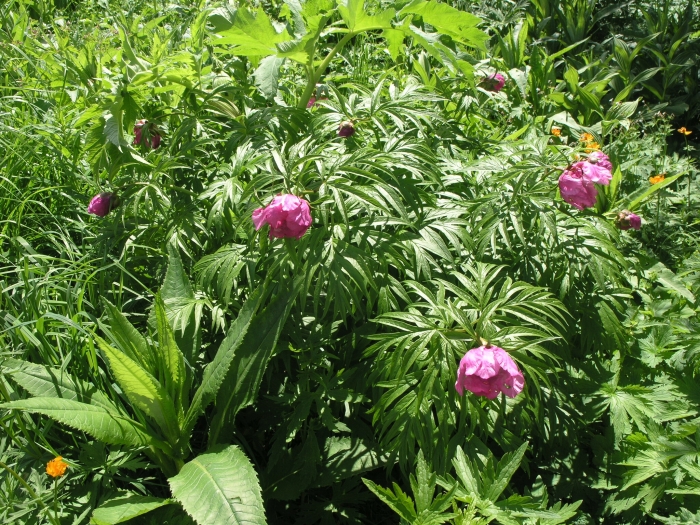Anomalous Peony
(Paeonia anomala)
Anomalous Peony (Paeonia anomala)
/
/

Oleg Kosterin
CC BY 4.0
Image By:
Oleg Kosterin
Recorded By:
Copyright:
CC BY 4.0
Copyright Notice:
Photo by: Oleg Kosterin | License Type: CC BY 4.0 | License URL: http://creativecommons.org/licenses/by/4.0/ | Rights Holder: Oleg Kosterin | Publisher: iNaturalist | Date Created: 2016-06-22T13:21:26-07:00 |
























Estimated Native Range
Summary
Paeonia anomala, commonly known as anomalous peony, is an herbaceous perennial native to the meadows and forest edges of northern European Russia, extending to northern Mongolia and south to the Tien Shan Mountains. It typically grows to a height of 1.5-3.25 feet with a similar spread and is characterized by its deeply incised, dark green leaves. The plant produces large, showy magenta-red flowers in late spring to early summer, which are quite attractive to pollinators. The flowers have a subtle fragrance and are followed by ornamental seed pods.
Anomalous peony is valued for its striking flowers and is often used in ornamental gardens for border plantings or as a specimen plant. It is relatively easy to maintain, requiring minimal care once established. This peony thrives in well-drained soil and can tolerate a range of light conditions, from full sun to partial shade. While it is self-fertile and capable of producing seeds, it can also be propagated by division. In traditional medicine, Paeonia anomala has been used for treating various ailments, although scientific evidence supporting these uses is limited. Gardeners should be aware that, like other peonies, it can suffer from peony wilt (Botrytis blight) and requires good air circulation to minimize disease risk.CC BY-SA 4.0
Anomalous peony is valued for its striking flowers and is often used in ornamental gardens for border plantings or as a specimen plant. It is relatively easy to maintain, requiring minimal care once established. This peony thrives in well-drained soil and can tolerate a range of light conditions, from full sun to partial shade. While it is self-fertile and capable of producing seeds, it can also be propagated by division. In traditional medicine, Paeonia anomala has been used for treating various ailments, although scientific evidence supporting these uses is limited. Gardeners should be aware that, like other peonies, it can suffer from peony wilt (Botrytis blight) and requires good air circulation to minimize disease risk.CC BY-SA 4.0
Plant Description
- Plant Type: Herb
- Height: 1.5-2 feet
- Width: 1.5-2.5 feet
- Growth Rate: Slow, Moderate
- Flower Color: Pink, Red
- Flowering Season: Spring, Summer
- Leaf Retention: Deciduous
Growth Requirements
- Sun: Full Sun, Part Shade
- Water: Medium
- Drainage: Medium
Common Uses
Border Plant, Fragrant, Low Maintenance
Natural Habitat
Meadows and forest edges in northern European Russia, northern Mongolia, and south to the Tien Shan Mountains
Other Names
Common Names: Anomalous Peony, Asian Peony
Scientific Names: , Paeonia anomala, Paeonia laciniata,
GBIF Accepted Name: